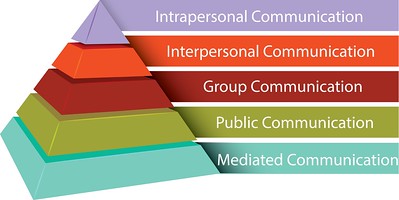Congruence in Communication
Congruence in communication refers to the alignment between verbal and non-verbal messages. It is important for effective and clear communication.
When verbal and non-verbal messages are congruent, the audience can better understand the intended message, trust the communicator, and feel confident in the communication process. Incongruence, on the other hand, can lead to confusion, mistrust, and misunderstandings. Non-verbal cues such as body language, facial expressions, and tone of voice play a significant role in conveying meaning and emotions.
By being aware of and practicing congruence in communication, individuals can enhance their ability to connect with others and convey their messages accurately.

Credit: www.youtube.com
Understanding Congruence In Communication
Congruence in communication refers to the alignment between verbal and nonverbal signals, ensuring consistency and authenticity. It is crucial for effective communication as it enhances trust and understanding between individuals. When there is congruence, both the message and the facial expressions, tone of voice, and body language convey the same meaning, leading to clearer communication.
This alignment creates a sense of credibility and reliability, fostering stronger relationships and more successful interactions. Congruence impacts effective communication by reducing misunderstandings and ambiguity, allowing messages to be accurately interpreted. It shows honesty, sincerity, and authenticity, making the communication process more genuine and meaningful.
When individuals are congruent in their communication, it facilitates empathy and connection, resulting in improved collaboration, problem-solving, and overall communication effectiveness.
Nonverbal Cues And Congruence
Nonverbal cues are a crucial aspect of congruent communication. They hold immense importance in conveying our thoughts and emotions accurately. Examples of nonverbal cues include facial expressions, gestures, and body language. When verbal and nonverbal messages align, it strengthens the overall impact of our communication.
Achieving this alignment requires conscious effort and awareness of our own nonverbal behaviors. By paying attention to our tone of voice, posture, and eye contact, we can ensure that our nonverbal cues enhance and support our verbal messages. This alignment improves understanding and trust in interpersonal interactions.
Consequently, it helps to minimize misunderstandings and promotes effective communication. Developing an understanding and mastery of nonverbal communication is essential for building stronger relationships and fostering successful communication in various personal and professional settings.
Verbal Congruence
Effective communication requires verbal congruence, which involves using language to convey messages that align with our intentions. By carefully choosing words and expressions, we can improve the clarity and consistency of our communication. Techniques such as active listening and observing non-verbal cues can enhance verbal congruence.
It is important to express ourselves authentically and be aware of any discrepancies between our words and non-verbal signals. This ensures that our message is received accurately and builds trust and understanding with the listener. Verbal congruence can be achieved through self-awareness, empathy, and practice, ultimately leading to more effective and meaningful interactions.
By focusing on the role of words in conveying congruent messages, we can improve our communication skills and foster harmonious relationships.
Building Trust Through Congruence
Building trust through congruent communication is essential in any relationship. Congruent communication fosters trust by promoting honesty and transparency. It involves aligning our verbal and nonverbal cues, ensuring consistency between our words and actions. Overcoming barriers to congruent communication is crucial for building trust, such as active listening, empathizing, and validating others’ perspectives.
Strategies to enhance trust through congruent communication include being genuine, using open and honest language, and practicing non-judgmental communication. By practicing congruent communication, we create an environment where trust can flourish, strengthening our connections with others. Trust, in turn, forms the foundation for successful relationships and effective collaboration.
When we communicate congruently, we build trust and foster stronger connections with those around us.
Congruence In Various Communication Contexts
Congruence in communication plays a crucial role in various contexts, such as personal relationships, professional settings, and public speaking. In personal relationships, being congruent means aligning one’s verbal and non-verbal cues, conveying authenticity and trust. This fosters effective communication and strengthens the bond between individuals.
In professional settings, congruence is equally important, as it ensures that one’s words, actions, and body language are consistent, promoting credibility and professionalism. Additionally, when it comes to public speaking and presentations, being congruent enhances the speaker’s ability to engage the audience by projecting confidence and conviction.
By practicing congruent communication across different contexts, individuals can convey their message effectively and establish meaningful connections with others. So, let’s explore the power of congruence in communication and its impact in various situations.
Developing Congruence In Communication
Developing congruence in communication requires self-awareness and self-reflection. It is crucial to understand our own emotions and thoughts. Building rapport and empathy with others is also essential. By putting ourselves in their shoes, we can better connect and communicate with them.
Additionally, practicing active listening plays a significant role in improving congruence. When we truly listen to others, we can understand their needs, feelings, and perspectives. This helps us respond authentically and in alignment with our words and actions. In turn, this fosters trust and effective communication.
Practicing self-awareness, building rapport, and active listening are key ingredients to develop congruence in our interactions. It is an ongoing process that requires mindful effort and practice. By consistently applying these skills, we can create meaningful connections and strengthen our relationships.
The Impact Of Incongruence
Incongruent communication can have a significant impact on relationships and outcomes. Signs of incongruence include mixed verbal and nonverbal messages, contradicting statements, and inconsistencies in tone. When communication is incongruent, it can lead to confusion, misunderstandings, and a lack of trust between individuals.
Resolving incongruence requires open and honest dialogue, active listening, and a commitment to clarity. By addressing incongruence, relationships can become stronger, as people feel understood and validated. Furthermore, incongruent communication can hinder the achievement of desired outcomes, as it creates barriers to effective collaboration and problem-solving.
When individuals are not in alignment, goals may be compromised, and conflicts may arise. Therefore, fostering congruence in communication is crucial for promoting healthy relationships and achieving successful outcomes.
Cultivating Congruence In Digital Communication
Cultivating congruence in digital communication poses various challenges, from the lack of non-verbal cues to the potential misinterpretation of messages. Expressing congruence in online interactions requires careful strategies. One must find a delicate balance between authenticity and professionalism, crafting messages that align with their true self while maintaining a suitable tone for the digital environment.
By being aware of the potential pitfalls and challenges of digital communication, individuals can navigate these obstacles more effectively. Whether it’s through employing empathetic language, offering clear and concise messages, or actively listening to others, expressing congruence in online interactions is essential for fostering meaningful connections.
Developing these strategies and adapting them to different digital platforms can help individuals establish trust and understanding, ultimately leading to more successful and authentic digital communication experiences.
Practicing Congruent Communication Skills
Practicing congruent communication skills is vital for effective interpersonal interactions. By engaging in exercises and activities specifically designed to develop congruence, individuals can enhance their ability to communicate authentically and honestly. Applying these skills in everyday life helps build strong relationships and fosters mutual understanding.
Seeking feedback from others and continuously striving for improvement is essential in cultivating congruent communication skills. Actively listening and validating others’ perspectives allows for open and respectful dialogue. By expressing thoughts, emotions, and intentions in a transparent manner, individuals can avoid miscommunication and misunderstandings.
Taking ownership of one’s words and actions promotes trust and credibility in relationships. Embracing the concept of congruence in communication leads to more meaningful connections and healthier interactions with others.
Frequently Asked Questions Of Congruence In Communication
What Is An Example Of Congruence Communication?
An example of congruence communication is when your words, tone, and body language all align with one another. For instance, if you say “I’m happy to help,” while smiling and maintaining eye contact, it conveys genuine sincerity. This congruent communication builds trust and fosters effective relationships.
Conversely, if your words, tone or body language contradict each other, it can create confusion and mistrust. Consistency is key in congruent communication to ensure that what is being said is congruent with how it is being conveyed. By honing this skill, you can enhance both personal and professional interactions.
Remember, congruence communication involves aligning verbal and non-verbal cues to convey authenticity and build connections.
Why Is Congruence Important In Communication?
Congruence is crucial in communication because it ensures clear and effective messaging. When there is congruence, the words, tone, and body language align with one another. This harmony promotes understanding and trust between the sender and the receiver. When people communicate congruently, their verbal and nonverbal cues match, reducing any potential confusion or misinterpretation.
The consistency between what is said and how it is said builds credibility and authenticity. Such congruence allows the listener to fully trust the message being conveyed, as it appears genuine and reliable. In contrast, incongruent communication can lead to mixed signals, distrust, and miscommunication.
When individuals are congruent in their communication, they can express their thoughts and feelings clearly, leading to more effective interactions and building stronger relationships.
What Is Congruence In Nonverbal Communication?
Congruence in nonverbal communication refers to the alignment between a person’s verbal and nonverbal messages. It is the harmony or consistency between what is being said and how it is being expressed through body language, facial expressions, gestures, and tone of voice.
When verbal and nonverbal cues match, it creates trust and credibility, enhancing the effectiveness of communication. In contrast, incongruence can lead to confusion, distrust, and misunderstanding. For instance, if someone says they are happy but their facial expression and body language convey sadness, the nonverbal cues are incongruent with the verbal message.
Congruence in nonverbal communication allows for clearer and more authentic expression, helping individuals better understand and connect with each other.
What Is Congruence In Communication In Social Work?
Congruence in communication in social work refers to the alignment between a social worker’s verbal and non-verbal behavior. It involves being genuine, sincere, and transparent in interactions with clients. By demonstrating congruence, social workers ensure that their words, tone, and body language all convey the same message, building trust and rapport with clients.
Congruent communication enables clients to feel understood, validated, and respected. It requires social workers to be self-aware, to reflect on their own feelings and biases, and to be able to express them appropriately. By practicing congruence, social workers create a safe and supportive environment for clients to express their emotions and concerns openly.
This open communication facilitates a collaborative working relationship, leading to more effective interventions and positive outcomes for clients.
Conclusion
Communication is an essential aspect of human interaction, and congruence plays a crucial role in its effectiveness. By aligning our verbal and non-verbal cues, we can ensure a more coherent and impactful exchange of ideas, emotions, and understanding. Congruence in communication fosters trust and authenticity, resulting in stronger relationships and successful collaborations.
A key benefit of congruent communication is its ability to enhance clarity and comprehension. When our words and body language are in harmony, our message becomes more memorable and persuasive, making it easier for others to grasp our intentions and respond accordingly.
It also fosters open and honest dialogue, as people feel more comfortable sharing their thoughts and feelings when they sense congruence in the communication process. Furthermore, congruence in communication leads to more effective problem-solving and conflict resolution. When there is alignment between what we say and how we say it, we create an atmosphere of mutual understanding and cooperation.
This allows for a smoother resolution of conflicts, as all parties involved feel heard and respected. Congruence in communication is a powerful tool for enhancing understanding, building trust, and resolving conflicts. By striving to align our words with our non-verbal cues, we can create more meaningful connections and achieve better outcomes in our personal and professional relationships.




